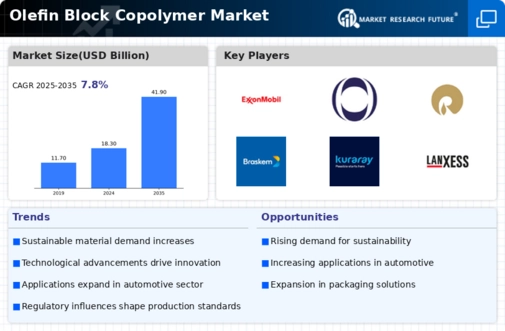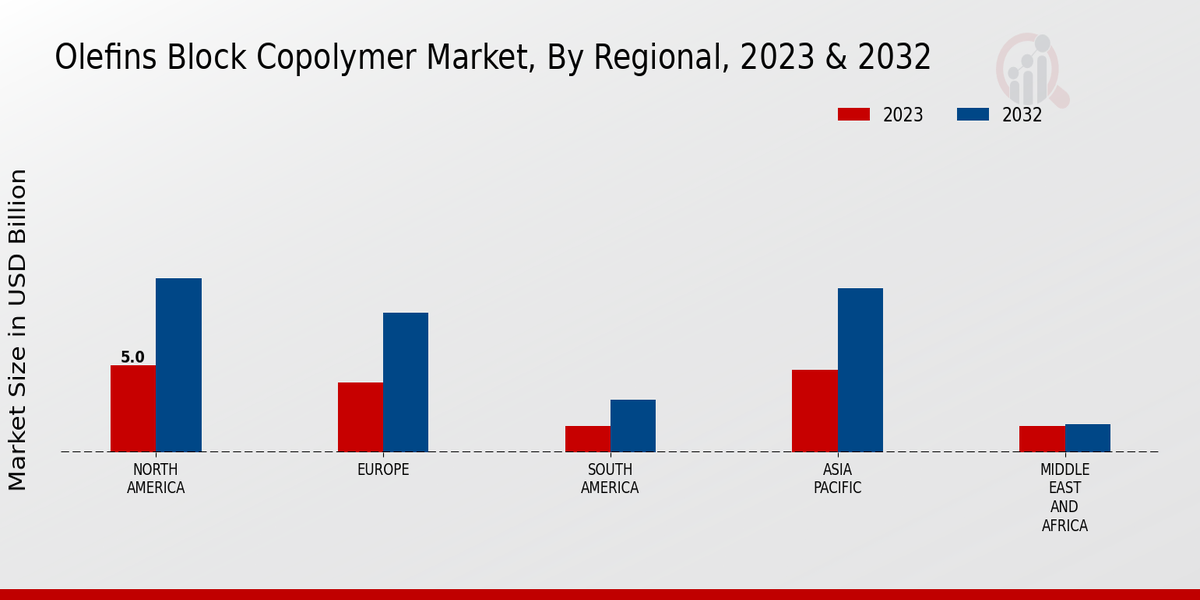Market Growth Projections
The Global Olefin Block Copolymer Market Industry is poised for substantial growth, with projections indicating a market value of 18.3 USD Billion in 2024 and an anticipated increase to 41.9 USD Billion by 2035. This growth trajectory reflects a compound annual growth rate (CAGR) of 7.82% from 2025 to 2035, driven by various factors including technological advancements, increased applications across industries, and a growing emphasis on sustainability. The market dynamics suggest a robust future for olefin block copolymers, as they continue to find new applications and meet the evolving needs of diverse sectors.
Expansion of the Construction Industry
The expansion of the construction industry significantly impacts the Global Olefin Block Copolymer Market Industry. As urbanization continues to rise globally, there is an increasing demand for construction materials that offer durability and flexibility. Olefin block copolymers are increasingly utilized in construction applications, such as roofing membranes and insulation materials, due to their excellent weather resistance and mechanical properties. This trend is expected to drive market growth, as the construction sector is projected to expand in the coming years, thereby enhancing the demand for high-performance materials like olefin block copolymers.
Rising Demand for Lightweight Materials
The Global Olefin Block Copolymer Market Industry experiences a surge in demand for lightweight materials across various sectors, particularly in automotive and packaging. As manufacturers strive to enhance fuel efficiency and reduce emissions, the adoption of olefin block copolymers, known for their lightweight properties, becomes increasingly prevalent. This trend is underscored by the projected market value of 18.3 USD Billion in 2024, reflecting a growing recognition of the benefits these materials offer. The automotive sector, in particular, is likely to leverage these materials to meet stringent regulations, thereby driving the overall growth of the Global Olefin Block Copolymer Market Industry.
Growing Applications in the Automotive Sector
The automotive sector plays a pivotal role in the expansion of the Global Olefin Block Copolymer Market Industry. With the increasing emphasis on sustainability and fuel efficiency, manufacturers are increasingly incorporating olefin block copolymers into vehicle components. These materials offer excellent flexibility, durability, and resistance to environmental factors, making them ideal for various automotive applications. The anticipated growth in the automotive industry, coupled with the projected market value of 41.9 USD Billion by 2035, suggests a promising future for olefin block copolymers as key materials in the development of innovative automotive solutions.
Technological Advancements in Polymer Production
Technological innovations in polymer production processes significantly influence the Global Olefin Block Copolymer Market Industry. Advances in catalytic processes and polymerization techniques enhance the efficiency and quality of olefin block copolymers, leading to improved performance characteristics. These advancements not only reduce production costs but also expand the application range of these materials in industries such as consumer goods and healthcare. As a result, the market is projected to grow at a CAGR of 7.82% from 2025 to 2035, indicating a robust trajectory fueled by ongoing technological improvements in the production of olefin block copolymers.
Increased Focus on Sustainable Packaging Solutions
The Global Olefin Block Copolymer Market Industry is witnessing a heightened focus on sustainable packaging solutions, driven by consumer demand for environmentally friendly products. Olefin block copolymers, with their recyclability and reduced environmental impact, are increasingly favored in packaging applications. This shift aligns with global sustainability goals and regulations aimed at reducing plastic waste. As companies strive to enhance their sustainability profiles, the adoption of olefin block copolymers in packaging is likely to accelerate, contributing to the overall growth of the market. The increasing regulatory pressures and consumer preferences for sustainable options further bolster this trend.


























Leave a Comment